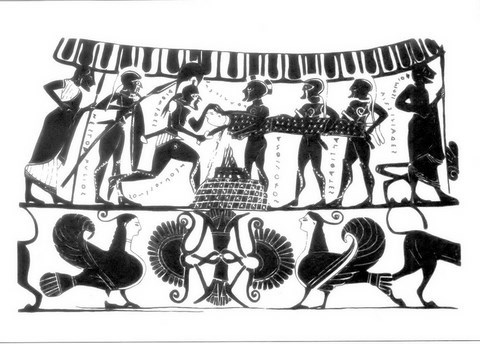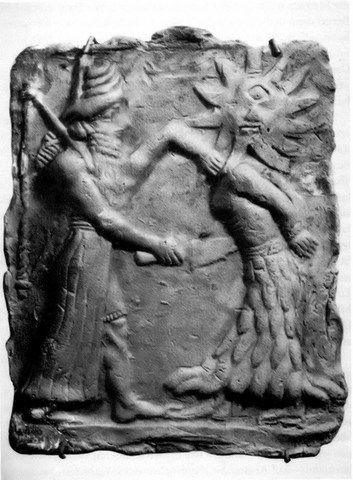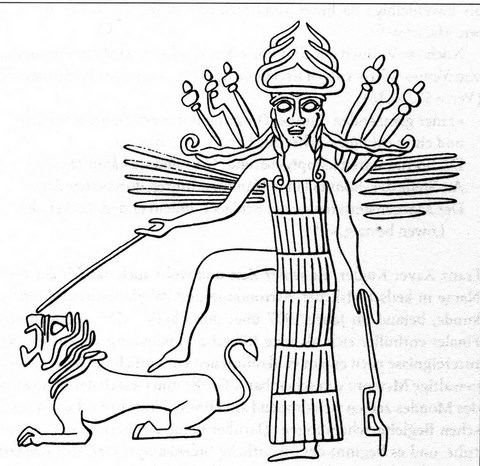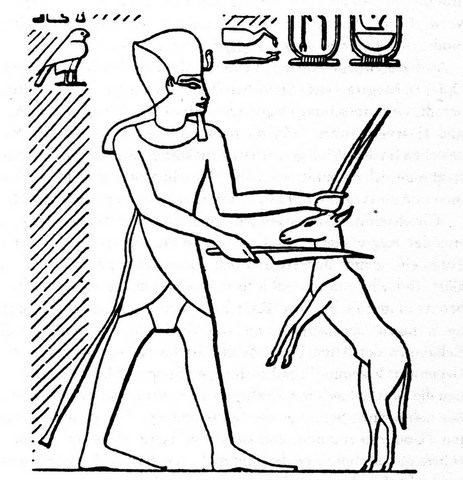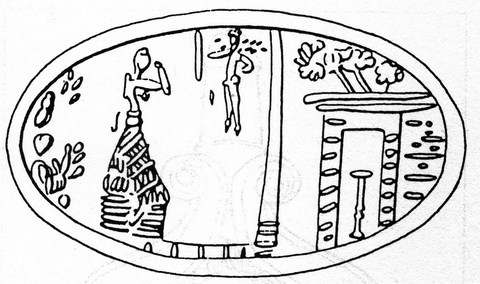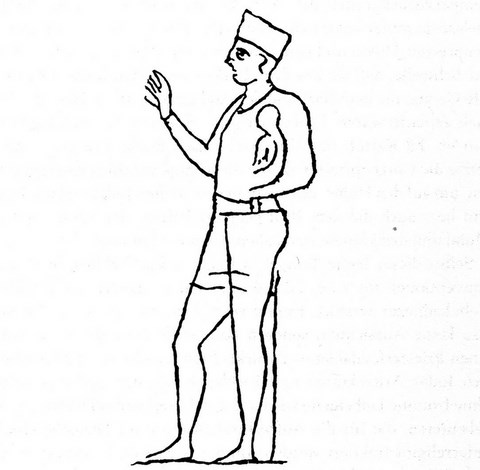Gunnar Heinsohn
The Creation of the Gods - Sacrifice as the Origin of Religion
Did we sacrifice to the gods, or did we deify the sacrificed?
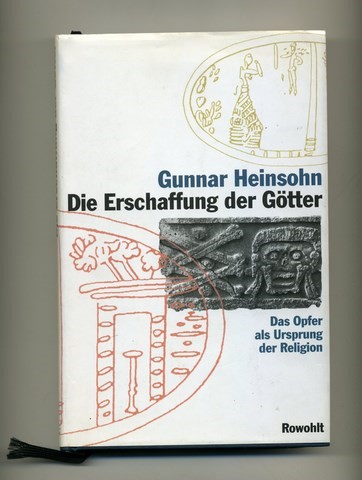
Humans and animals who were robbed of their lives in blood rituals as impersonators of godly beings - as representations of something still that remains to be defined - confront the science of religion with its most vexing challenges. Because in the great rituals of the Bronze Age such beings are ritually put to death, rather then being themselves the recipients of sacrifices, our understanding of the gods becomes ever more blurred. (...)
The author feels himself committed, in his approach to sacrifice, to a decidedly conservative attitude. The retrospectively breathtaking audacity with which scholars, since the assertion of evolutionism, have stopped evaluating the subject matter of religious sacrifice, and have instead subjected them to their own bureaucratic principles, in order to then evacuate all the findings which did not match their expectations, this audacity the author could never make his own. The massive indications of overwhelming natural catastrophes which are so clearly to be seen in geological and archaeological layers (albeit only investigated in recent times), as well as in the written documents of the early high cultures, were packed into implausible constructs, turned into enigmas and allegories, ignored, ridiculed or at best - since the beginning of the 20th century - psychoanalyzed as the discharge of confused souls.
In the course of this book we will show that the soft evolutionism of the Lyell-Darwin school has succeeded in blocking scientific research and reflection in its depth for now well over a century and a half. In the 800-page final version of van der Leeuws Phenomenology of Religion (1956), which had its last edition in 1970, the terms “catastrophe,” or “cataclysm” simply do not occur at all. In this work, religious-historical Darwinism attained its summit. Practically everything which was fundamental for the understanding of ancient religions was passed over without a word.
The elucidation of myth, ritual and religion must now begin almost anew. For this we will need to take seriously once more especially the most shocking contents of the early religious texts. We will be holding them up therefore next to the no less catastrophically stamped finds of archaeology and estimate them anew in the light of the latter. It is well known that one advances often with the solution of an enigma - in this case, the sacrifice of celestial deities - only when one addresses it together with other enigmas from adjacent fields - in this case the geological and archaeological destruction layers, as well as the myths of cosmic revolutions of the ancient peoples.
Table of Contents
I. Introduction: Did we sacrifice to the deities, or did we deify the sacrificed? (1st installment)
II. What appears easily understandable about sacrifice and what seems enigmatic? The purposes of religious theory. (1st installment)
III. The academic dispute around the understanding of blood sacrifice. (2nd installment)
IV. The sudden emergence of the great sacrificial cults and of priest-kingship at the beginning of the Bronze Age. (2nd installment)
V. Global catastrophes in the “Era of Sacrifice” between Stone Age and Iron Age. (3rd installment)
VI. Temples and places of sacrifice on top of catastrophic layers. (3rd installment)
VII. Sacrifice as a game-therapy of collective “healing” for cosmically “disturbed” communities. (4th installment)
VIII. The creation of the professional arts. (4th installment)
IX. How did we arrive at gods in animal, human, or mixed shape? (5th installment)
X. The rejection of sacrifice, birth of monotheism and isolation of the Jews among nations. (6th Installment)
XI. The son-sacrificing god of the Christians against the son-sparing god of Abraham. (6th Installment)

Gunnar Heinsohn: Biography
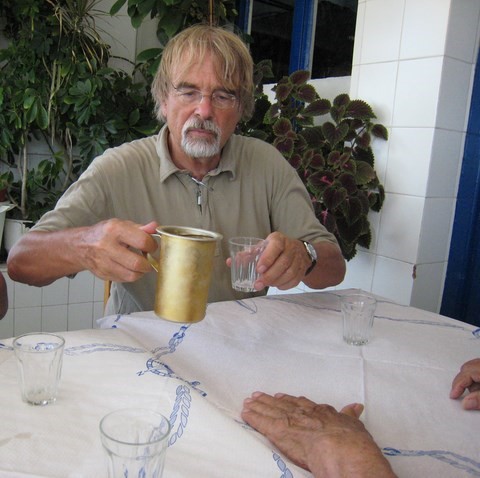
Gunnar Heinsohn (born 1943 in Gdynia/Poland, emeritus professor at Universität Bremen (University of Bremen/Germany) has studied sociology, history, psychology, economics and religious studies at the Freie Universität Berlin. He has earned a university diploma in sociology in 1971, as well as doctorates summa cum laude in both sociology (1973), and in economics (1982).
From 1976 to 1978 he has lived in Israel. His publication list exceeds 750 titles including more than thirty monographies. Since 1984 he has been a tenured professor at Universität Bremen where he has served, from 1993-2009, as speaker of Europe's first university institute devoted to comparative genocide research, the Raphael-Lemkin Institut für Xenophobie und Genozidforschung [Institute for xenophobia and genocide research]. He has published in the major newspapers and magazines of the German language area as well as in the Wall Street Journal, the International Herald Tribune, Newsweek, Le Monde, the Financial Times, the Weekly Standard, NRC-Handelsblad (Amsterdam). In recent years, he has been involved in fierce controversies over his proposals of limiting to five years the reception of welfare benefits in Germany.
Gunnar received the 2015 LIBERTY AWARD.
He died in Gdansk surrounded with love on February 16, 2023, six months after having been diagnosed with cancer.
His research focuses on the HISTORY AND THEORY OF CIVILIZATION with special emphasis on (i) Population/Childhood/Family, (ii) Economy, (iii) Religion, (iv) Genocide/War, and (v) Chronology.
(i) Major subjects of Population/Childhood/Family were dealt with in (1) Vorschulerziehung in der bürgerlichen Gesellschaft [1991; 'Pre-school Education in Modern Times'] (Frankfurt am Main: S. Fischer 1974). (2) Theorie des Kindergartens und der Spielpädagogik ['Theory of the Kindergarten and Play-Pedagogy'] (Frankfurt am Main: Suhrkamp, 1975; co-author: B.M.C. Knieper; translations into Danish and Swedish). (3) Theorie des Familienrechts: Geschlechtsrollenaufhebung, Kindesvernachlässigung, Geburtenrückgang [1974; 'Theory of Family Law: Diminishing Sex Role differences, Child Neglect and Falling Birth Rates'] (Frankfurt am Main: Suhrkamp, 19762, co-author: R. Knieper). (4) The Bancruptcy of the Economics of Population: Why Economists have Failed to Develop an Economic Theory of the Production of Human Beings, (Universität Bremen: Forschungsgruppe 'Postkeynesianische Ökonomie', als Diskussionsbeiträge zur Politischen Ökonomie, Nr. 21, 1979, co-author: O. Steiger); (5) Menschenproduktion: Allgemeine Bevölkerungstheorie der Neuzeit [The 'Production of Human Beings: General Theory of Population in Modern Times'] (Frankfurt am Main: Suhrkamp, 1979; 1986; co-authors: R. Knieper and O. Steiger).
(ii) In the field of Economics appeared (6) Das Kibbuz-Modell -Bestandsaufnahme einer alternativen Wirtschafts- und Lebensform nach sieben Jahrzehnten [ 'The Kibbutz as a Model: An Alternative Economy and Life Style after Seven Decades'] (Frankfurt am Main: Suhrkamp, 1982). (7) Privateigentum, Patriarchat, Geldwirtschaft. Eine sozialtheoretische Rekonstruktion zur Antike ['Private Ownership, Patriarchy and the Monetary Economy: A Socio-theoretical Reconstruction of Occidental Antiquity'] (Frankfurt am Main: Suhrkamp 1984). (8) Eigentum, Zins und Geld: Ungelöste Rätsel der Wirtschaftswissenschaft ['Property, Interest and Money: Unsolved Enigmas of Economics'] (Reinbek: Rowohlt, 1996; co-author: O. Steiger; corr. 5th ed Marburg: Metropolis 2009). (9) Kontroversen der Geldentstehung: Streit um die Anfänge des Geldes ['Controversies on the Origin of Money'] (Universität Bremen: Institut für Konjunktur und Strukturforschung, als IKSF Discussion Paper, Nr. 11, 1997, co-author: O. Steiger); (10) Das Eurosystem und die Verletzung der Zentralbankregeln: Was man darüber wissen muß und was dazu gerne verschwiegen wird ['The Euro-System and the Violation of the Art of Central Banking'] (St. Gallen: Managementzentrum [MZSG], 2000, co-author: O. Steiger). (11) The Property Theory of Interest and Money (London&New York: Routledge ["What Is Money?"]; co-author: O. Steiger). (12) Geld und Zins: Gemeinverständliche Grundlegung der Wirtschaftstheorie ["Money and Interest: A Popular Foundation of Economics"] (St. Gallen: Managementzentrum [MZSG], 2001). (13) Eigentumstheorie des Wirtschaftens versus Wirtschaftstheorie ohne Eigentum ['Property Theory of the Economy versus Economic Theory without Property' (Marburg: Metropolis, 2002, co-author: O. Steiger). (14) Eigentumsökonomik ["Property Economics"] (Marburg: Metropolis, 2006, 2008, co-author: O. Steiger). (15) A Property Economics Explanation of the 2008 Global Financial Crisis http://papers.ssrn.com/sol3/papers.cfm?abstract_id=1331712 (Social Science Research Network [SSRN] 2008). (16) Property Theory of the Market (Social Science Research Network [SSRN] 2009). In the Encyclopedia of Economic Works covering the most inspiring 650 works in economics of altogether 460 authors worldwide from antiquity to the 20th century, the author is the only living scholar of the German language area represented with four different studies (followed by Reinhard Selten [*1930; Nobel Price 1994] with three texts). See D. Herz and V. Weinberger, eds., Lexikon ökonomischer Werke: 650 wegweisende Schriften von der Antike bis ins 20. Jahrhundert, Düsseldorf: Wirtschaft und Finanzen, 2006, pp. 186-190. The money explanation of Eigentum, Zins und Geld [(8) above] is, since 2000, represented in the Geldmuseum der Deutschen Bundesbank (Money-Museum of the German Bundesbank, Frankfurt am Main) in juxtaposition with the money views of Aristotle, Adam Smith, Bernard Laum, and John Maynard Keynes.
(iii) Matters of Religion became the subject of (17) Theorie des Tötungsverbotes ['Theory of the Prohibition of Killing'] (Pamphlet 7 of L`invitation au voyage zu Alfred Sohn-Rethel (Festschrift zum 80. Geburtstag), Bremen: Wassmann, 1979). (18) Was ist Antisemitismus? - Der Ursprung von Monotheismus und Judenhaß - Warum Antizionismus? ['What is anti-Semitism? - The Origin of Monotheism and anti-Judaism. - Why anti-Zionism?'] (Frankfurt am Main: Eichborn, 1988). (19) Die Erschaffung der Götter: Das Opfer als Ursprung der Religion ['Creation of the Gods: Sacrifice and the Origin of Religion'] (Reinbek: Rowohlt, 1997) - English translation here.
(iv) Genocide and other mega-killings were dealt with in (20) Die Vernichtung der weisen Frauen: Beiträge zur Theorie und Geschichte von Bevölkerung und Kindheit ['The Elimination of the Wise Women: Contributions to the Theory and History of Population and Childhood'] (München: Heyne [19851], 20055; co-author: O. Steiger; translation into Swedish). (21) Warum Auschwitz? Hitlers Plan und die Ratlosigkeit der Nachwelt ['Why Auschwitz? Hitler's Plan and The Perplexity of Holocaust Scholars'] (Reinbek: Rowohlt, 1995; translation into French in prep.). (22) Was wollte Hitler? Auschwitz und die Lehre von den drei Weltzeitaltern ['What Was Hitler's Motive? Auschwitz and the Doctrine of the three Universal Epochs'] (Bremen: Raphael-Lemkin-Institut für Xenophobie- und Genozidforschung, 1996). (23) Anfang und Ende des Klimawahns ['Rise and Fall of the Climate Scare'] (St. Gallen: Managementzentrum [MZSG], 1997). (24) Post-Genocidal Reconciliation in Rwanda: Are There Lessons from Germany? (Universität Bremen: Raphael-Lemkin-Institut für Xenophobie- und Genozidforschung / Schriftenreihe Bd. 3, 1997). (25) Inflation and Witchcraft or the Birth of Political Economy: The Case of Jean Bodin Reconsidered (Universität Bremen: Institut für Konjunktur und Strukturforschung, als IKSF Discussion Paper, Nr. 8, 1997, co-autho: O. Steiger). (26) GUlag und Auschwitz: Ein Wort zur Klärung der Differenz ['GULag and Auschwitz: A Word on their Difference'] (Universität Bremen: Raphael-Lemkin-Institut für Xenophobie- und Genozidforschung / Schriftenreihe Bd. 6, 1998); (27) Lexikon der Völkermorde ["Encyclopedia of Genocides"] (Reinbek: Rowohlt, 1998, 1999; Swedish and Bulgarian translations in prep.). (28) "Why Was the Holocaust a Unique Genocide," Journal of Genocide Research II/2, 2000). (29) "Jüdische Sklaven Hitlerdeutschlands: Wie viele überlebten 1945 den Genozid und wie viele könnten im Jahr 2000 noch leben?" ['Jewish Slaves of Hitler's Germany: How Many Have Survived the Genocide in 1945 and How Many Could Still Be Alive in 2000)'] (Universität Bremen: Raphael-Lemkin-Institut für Xeno-phobie- und Genozidforschung / Schriftenreihe Bd. 9, 2001). (30) Entry "Genocide" (International Encyclopedia of the Social and Behavioral Sciences, London: Elsevier, 2001); (31) Söhne und Weltmacht (['Sons and World Power'] Zuerich: Orell & Füssli, 2003). 'Sons and World Power' (a scholastic bestseller with 10th impression in 2008 and Dutch, Japanese as well as Polish editions in 2008/2009) tries to illuminate the role of youth bulges in mega-killings of past, present, and future. From 2005 to 2009, the author gave lectures on the subject to Germany's secret services (BND; BfV), commanders of major NATO forces, Germany's National Academy of Security Policy as well as its Ministry of the Interior. Together with Philippe Bourcier de Carbon (Paris), he was the only expert from continental Europe consulted for the study "The Graying of the Great Powers" by the Center for Strategic and International Studies (CSIS; Washington DC 2008).
(v) On Chronology were published (32) Nullpunkt Abraham. Abraham und die Chronologien Mesopotamiens und Ägyptens ['Point Zero: Abraham and the Chronologies of Mesopotamia and Egypt'] (Basel: PAF, 1987). (33) Wie alt ist das Menschengeschlecht? [1991; 'How Ancient Is Mankind?'] (München: Gräfelfing 1996, 2003. (34) Die Sumerer gab es nicht: Von den Phantom-Imperien der Lehrbücher zur wirklichen Epochenabfolge in der "Zivilisationswiege" Südmesopotamien ['Have the enigmatic Sumerians been the lost Chaldaeans: From the Phantom Empires of Modern Textbooks to the Real Sequence of Epochs in Southern Mesopotamia's "Cradle of Civilization"' (Frankfurt am Main: Eichborn, 1988). (35) Wann lebten die Pharaonen? Archäologische und technologische Grundlagen für eine Neuschreibung der Geschichte Ägyptens und der übrigen Welt [1991; 'When Did the Pharaohs Thrive? Archaeological and Technological Foundations for the Re-writing of Ancient History'] (Frankfurt/Main: Eichborn, 1990; München: Mantis, 1997, 2065; co-author: H. Illig). (36) Wer herrschte im Industal? Die wiedergefundenen Imperien der Meder und der Perser [1993; 'Who Ruled in the Indus Valley? The Rediscovery of the Medish and Akhaemenid Empires'] (Gräfelfing: Mantis, 19972). (37) Assyrerkönige gleich Perserherrscher! Die Assyrienfunde bestätigen das Achämenidenreich [1992; 'Assyrian Kings as Persian Rulers in Assyrian Garb: The Archaeology of Assyria Confirms the Existence of the Akhaemenid Empire'] (Gräfelfing: Mantis, 19962). (38) Empires Lost and Found: Stratigraphy and the Search for the Great Powers of the Past, in http://www.cais-soas.com/CAIS/History/empires_lost_found.htm CAIS (The Circle of Ancient Iranian Studies ) 2006a. (39) Cyaxares: Media's Great King in Egypt, Assyria & Iran, in CAIS (The Circle of Ancient Iranian Studies) 2006b; http://www.cais-soas.com/CAIS/History/madha/cyaxares_Egypt_assyria.htm CAIS (The Circle of Ancient Iranian Studies) 2006b; (40) "Die Wiederher-stellung der alten Geschichte" ['The Reconstruction of Ancient History'], Introduction to the new edition of Die Sumerer gab es nicht (see (34) above), Gräfelging: Mantis 2007, pp. 9-65).

Gunnar Heinsohn at the Temple of Demeter in Naxos, Greece (2012).


